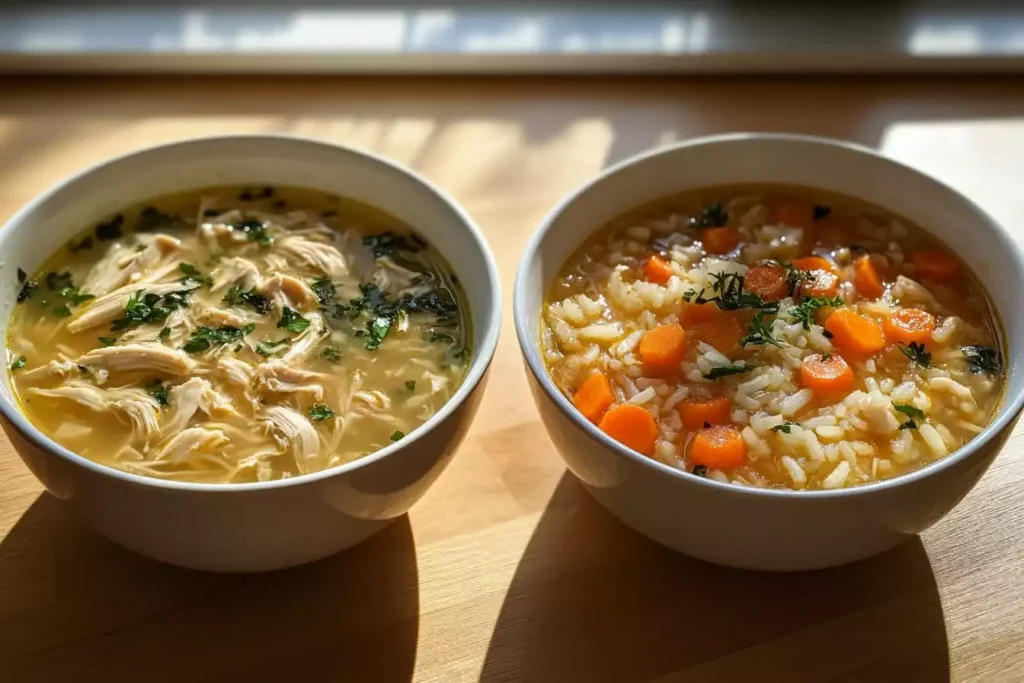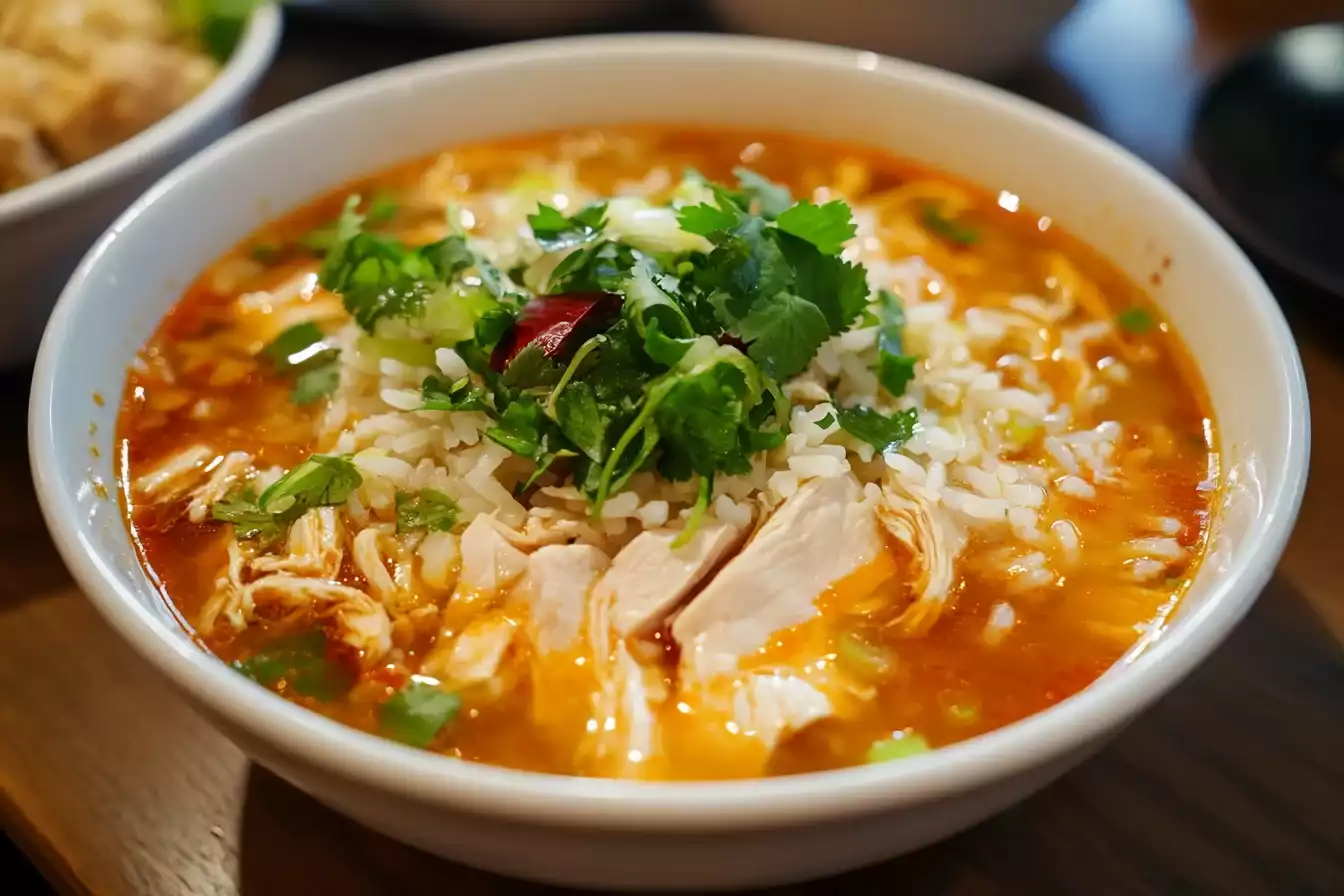Have you ever made a pot of chicken and rice soup only to find it’s disappointingly thin? You’re not alone! Achieving that perfect, comforting, creamy texture can be tricky, but it doesn’t have to be. This ultimate guide will explore 7 proven methods on how to thicken chicken and rice soup and transform it from watery to wonderfully rich. Whether you are looking for a hearty meal or a soothing remedy for a cold, mastering how to thicken your soup will ensure every spoonful is satisfying.
Table of Contents
Why is My Chicken and Rice Soup So Watery?

Before diving into solutions, it’s helpful to understand why your soup might be lacking in body. There are several common reasons why chicken and rice soup ends up too thin. One of the most frequent culprits is simply not using enough of a thickening agent, or not allowing enough time for any natural thickening to occur. Another factor can be the balance of broth to other ingredients; too much broth will dilute your soup.
Understanding these issues will help you prevent them in the future and create a more satisfying meal every time. Sometimes, the rice you choose can also affect the soup’s consistency, with some varieties releasing less starch than others. This article will provide you with all the info and tips you need.
Another key factor could be not using enough chicken, or the type of chicken, such as using chicken breast, which has less fat and therefore less natural gelatin to thicken the soup, making it thin. In addition, the ratio of water or broth to the other ingredients can affect the thickness of the soup.
7 Incredible Ways to Thicken Your Chicken and Rice Soup
Now, let’s get to the heart of the matter: the 7 incredible techniques to thicken your chicken and rice soup. We’ll explore various methods using different ingredients and approaches so you can find the one that best suits your needs and preferences. Each approach offers a unique way to achieve a creamy consistency, ensuring your soup is perfect every time. We’ve got you covered, whether you’re looking for a classic approach or a quick fix.
1. The Starch Powerhouse: Cornstarch Slurry
Cornstarch is a go-to thickener for many soups, and for good reason. It’s simple, effective, and easily accessible. The key is to create a slurry with cold water before adding it to the hot soup. This prevents clumping and ensures an even thickening. Start by mixing equal parts cornstarch and cold water. Then, whisk this mixture gradually into your simmering soup, and you will see it thickening before your eyes.
Remember, cornstarch needs heat to activate. This will thicken your soup and will make it have a smoother and creamy consistency. This is a very effective approach to fix a thin soup. Using a cornstarch slurry is a quick and easy way to adjust the texture of your chicken and rice soup in no time.
[Insert Image 1 here of cornstarch slurry in a bowl with a whisk and a pot of chicken and rice soup in the background. Alt text: Cornstarch slurry in a bowl preparing to thicken chicken and rice soup.]
2. Flour Power: The Roux Method
Similar to using cornstarch, flour is another great option for thickening soups. However, unlike cornstarch, flour needs to be cooked before it can effectively thicken, so the best way to thicken your soup with flour is by using the roux method. To do this, melt equal parts butter and flour in a separate pan, cook this mixture until you have a paste, and then add this to the hot soup, making sure to stir it all together.
Cooking the flour beforehand not only helps to remove any raw flavor but also helps it blend seamlessly into the soup, ensuring a velvety texture. A roux adds richness and depth to your chicken and rice soup as well as a thicker consistency. This method creates a wonderful richness and is worth the extra steps for a satisfying result. Check out our guide on the best way to thicken a soup for more tips and methods.
3. The Natural Thickener: Rice Starch
The rice itself can become a natural thickener. If your soup has been cooking for a while, some of the starch from the rice will already be in the broth. You can enhance this by slightly mashing some of the rice against the side of your pot using a spoon. This releases more starch, which will thicken the soup from the inside, giving it a nice, full-bodied texture.
This is a simple way to get a thicker soup without using extra ingredients or steps. Simply mashing some of the cooked rice will also add more texture as some of the rice will still be whole, giving your chicken and rice soup an overall heartier feel. This natural method is not only easy but also adds more depth of flavor. It’s an easy, natural way to enhance the texture of your soup.
4. Creamy Additions: Dairy Delights
Adding dairy is a great way to thicken and enrich your chicken and rice soup. Heavy cream, half-and-half, or even milk can significantly boost the texture. For the best results, stir in your chosen dairy at the end of the cooking process, just before serving. Avoid adding it directly to boiling soup to prevent it from curdling or separating.
Adding dairy adds a silky smoothness and a rich flavor, creating a truly indulgent soup. Using dairy is a fantastic choice if you prefer a creamy, decadent texture. The fat content in dairy helps create that creamy consistency we all crave in a good chicken and rice soup.
5. The Blending Technique: A Quick Fix
For a quick way to add body to your soup, use an immersion blender, or transfer part of the soup to a regular blender, and blend until it is creamy and smooth. The blended mixture can then be added back into the main pot of soup. This technique breaks down the rice and vegetables, releasing starches that act as natural thickeners.
Be very careful when blending hot liquids. Make sure to start the blender at a low speed and make sure the vent on the lid is open so steam can escape, or remove the center insert from the lid of a regular blender. Blending a portion of your soup is an effective way to get a thicker texture without altering the flavor.
6. Mashed Vegetables: A Healthy Boost
Adding cooked, mashed vegetables is another way to thicken your chicken and rice soup, all while adding a nutritional boost. Consider adding cooked potatoes, carrots, or even a little cooked squash, all of which can be easily mashed and stirred into the soup to act as a natural thickening agent. You can also add other vegetables, such as celery and onions, to enhance the flavor profile.
The starch from these vegetables helps to thicken the soup while also providing additional vitamins and minerals, offering a healthy and delicious alternative to other thickening methods. This also adds another layer of flavor to the soup. Adding mashed vegetables is an easy way to add both texture and nutritional value to your meal. It is a win-win!
[Insert Image 2 here of the final chicken and rice soup with garnishes in a bowl. Alt text: A bowl of thick chicken and rice soup garnished with herbs and a side of bread.]
7. Reduction: The Patient Approach
Sometimes, the best solution is simply to let your soup simmer and reduce. This process involves cooking the soup uncovered over low heat, allowing some of the liquid to evaporate. The result is a naturally thicker consistency as the ingredients and broth concentrate. This method will also intensify the flavors of the soup.
Patience is key here, as the reduction process can take some time. But if you don’t have much time, you can increase the heat a little but keep a close eye on your soup and stir it regularly. This will concentrate the flavors and help to thicken your soup. Reducing the liquid can enhance the overall taste and richness of your soup.
how to thicken chicken and rice soup? Tips for Success When Thickening Chicken and Rice Soup

Thickening your chicken and rice soup can be easy, but here are some additional tips to ensure you achieve the best results every time. These tips are intended to help you avoid common errors that can lead to clumpy or unappetizing soup.
- Start Slowly: When adding thickening agents like cornstarch or flour, always begin with a small amount and add more gradually until you reach your desired consistency. This prevents over-thickening.
- Stir Continuously: As you add the thickener, stir the soup constantly to ensure that everything is well combined and that there are no clumps.
- Avoid Overcooking: Once the soup has thickened, avoid overcooking, as this can cause the starches to break down and the soup to become thin again.
- Taste as You Go: Seasoning plays a big role in the final taste of the dish. Make sure to season to taste as you add the thickener to get the best possible flavor of the final dish.
- Use Cold Water or Broth: When making a slurry with cornstarch or flour, make sure you use cold water or broth to make sure there are no lumps in your mix.
- Balance of Ingredients: The key to a perfect soup is to have the correct balance of ingredients. Adjust the liquid to ingredient ratio according to your preference. Check out this article on how to balance flavors in a meal for more tips.
[Insert Image 3 here, a side-by-side comparison of thin vs. thick chicken and rice soup. Alt Text: Side-by-side comparison of watery chicken and rice soup and a thick, creamy version.]
Variations on Thickening Techniques
There are many options to modify the thickening techniques based on your dietary needs and the ingredients you have available. Here are some variations you might consider:
- Gluten-Free Options: If you’re gluten-free, you can use alternatives to flour, such as tapioca starch, arrowroot powder, or even a gluten-free flour mix.
- Vegan Options: For a vegan-friendly soup, skip the dairy, and use plant-based milk alternatives such as coconut milk, or cashew cream to make it creamy.
- Low-Carb: Skip the rice and thicken your soup using mashed cauliflower or other low-carb vegetables.
- Different Herbs and Spices: Don’t be afraid to experiment with adding other spices and herbs, such as thyme, parsley, or bay leaf, to enhance the flavor of your soup.
FAQs about Thickening Chicken and Rice Soup
Here are some frequently asked questions (FAQs) to address common concerns you may have when attempting to thicken your chicken and rice soup.
Can I add rice directly to soup?
Yes, you can add rice directly to soup, but it’s important to do it at the right time. For best results, add raw rice in the last 20-30 minutes of cooking, ensuring there’s enough liquid for the rice to absorb and cook through. Adding it too soon can cause the rice to become mushy. Always remember to give it a stir.
How do you keep rice from getting mushy in soup?
To keep rice from getting mushy in soup, it’s important to use the correct type of rice and also add it at the right time. Choose a long-grain rice, as it tends to hold its shape better than shorter varieties. Also, don’t overcook your soup, as this can cause the rice to break down. Adding rice in the last 20-30 minutes of cooking will ensure that it is cooked through but still maintains a nice texture.
Do you cook the chicken before putting it in soup?
It depends on the type of chicken you’re using. If you’re using raw chicken pieces, such as breasts or thighs, you can add them directly to the soup pot, but if you are using cooked chicken you should add it at the end. If you are using pre-cooked rotisserie chicken, or other pre-cooked chicken, it is best to add it at the end of cooking, and heat it through with the soup.
Conclusion: Achieve Perfect Chicken and Rice Soup Today!
Mastering how to thicken chicken and rice soup? is a skill that will elevate your cooking and bring comfort to your table. With these 7 simple techniques and a few helpful tips, you can say goodbye to thin, watery soup and hello to rich, creamy perfection. Whether you choose to blend, add dairy, or reduce, each method offers a delicious way to transform your soup. Try them all and find your favorite method and enjoy a hearty, satisfying bowl of chicken and rice soup. Don’t forget to use our guide to help you achieve the perfect chicken and rice soup every time. Now it’s your turn to try it out and make some amazing soup!
For More Articles Links:

